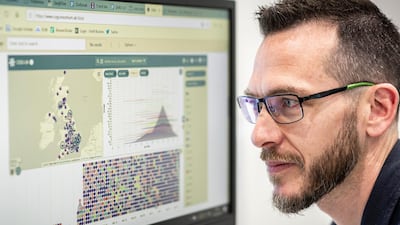Inside a medical institute in rural Britain, scientists are working to trace thousands of coronavirus cases.
Using live data from the British government, they work to identify different strands of the virus and how they came to the country.
Experts say the work is crucial to help officials decide if a localised lockdown – now in place in half of the UK – needs to be put in place.
Coronavirus is composed of 30,000 pairs of chemical units known as RNA or ribonucleic acid.
Once the virus enters a human cell, this RNA – a chemically different form of genetic material to human DNA – is replicated. This in turn produces more virus particles that can be shed and create new infections.
By sequencing the virus’s RNA, scientists can determine where infections originated and how they are spreading – which can highlight the best way to prevent new cases. The research can also determine if the virus is mutating.
When it comes to sequencing the coronavirus, the UK is the world leader, accounting for about half of the 160,000 samples sequenced globally.
About 3,000 of the UK’s tally have been analysed at the Quadram Institute, a research centre in Norwich in eastern England that is one of more than a dozen UK establishments carrying out sequencing.
And its work has never been more important. A second wave of Covid-19 is wreaking havoc on countries across the world. Many countries have reimposed lockdowns, while the pandemic has claimed more than a million lives globally so far.
Most samples are from the surrounding county of Norfolk, which could be the most heavily sequenced part of the world given its population of less than a million, according to Dr Justin O’Grady, who heads the institute’s coronavirus effort. The work has, says Dr O’Grady, who normally researches the genetic diversity of microorganisms, been “hectic and rewarding”.
“It’s a departure from my normal day job,” he says. “We have to respond quickly to outbreaks. There’s a large team of people and they’re all working very hard and they’re very good.
“It’s great to see the data being utilised directly for public health interventions.”
It takes several hours in the laboratory to complete the steps to sequence the viral RNA, which is dissolved in liquid after being collected by nasal swabs, throat swabs or both.
The viral RNA is cut into sections that are about 400 base pairs long, which are then sequenced and fitted together by machine like a jigsaw.
By analysing variation between samples from different areas, scientists can determine the pattern of evolution of the coronavirus. The genetic differences are caused by naturally occurring mutations, with the virus accumulating changes at a rate of about two base pairs per month.
An evolutionary tree of branches or lineages shows where samples originated, such as whether they are local or from somewhere else.
If lineages are assigned colours, researchers can produce pie charts showing where the coronaviruses found in a given area came from.
In a recent paper co-authored by Dr O’Grady based on results from more than 1,500 samples sequenced at the Quadram Institute, the researchers identified 100 distinct lineages. These in turn belonged to 26 global lineages, indicating the coronavirus has been introduced to this part of the UK multiple times.
“There are many, many different lineages,” says Dr O’Grady. “Some become extinct almost immediately. Some spread significantly through the community.
“The lockdown had a major impact on what was spread around, and reduced the number spreading, obviously. Certain lineages didn’t transmit; certain ones stayed.”
The majority of coronavirus samples in Norfolk can be traced back to lineages originating in France, Italy and Spain, mirroring, says Dr O’Grady, the picture across the UK.
Most importantly, because lineage data indicates how the coronavirus is spreading within an area, it can be used to control spread.
For example, samples from people working in a Norfolk food processing plant that suffered a coronavirus outbreak were almost identical, indicating the outbreak resulted from spread within the plant and not from multiple infections from outside. This meant that measures to prevent spread within the facility were vital.
Similarly, sequencing identified a “sub-lineage” associated with six care homes, showing the coronavirus was spreading from one facility to another.
Sequencing data can be provided in as little as 24 hours, helping public health officials to decide the best way to control spread.
“It’s great to see the data we [provide] being used directly for public health interventions,” says Dr O’Grady.
The Norwich institution is one of several across the UK and their work is proving crucial in tackling the pandemic.
Sequencing information also offers clues as to whether the coronavirus is evolving in a way that could render early vaccines ineffective. The indications so far are welcome.
Dr O’Grady says there have been about 12,000 mutations in the coronavirus’s genome in total, with individual samples typically carrying about 10. Crucially, most seem to be insignificant.
“They appear and they disappear,” he says. “They’re not in regions [of the coronavirus genome] that are important. Typically things that cause problems are in the spike protein or that change the shape of the [viral] proteins."


